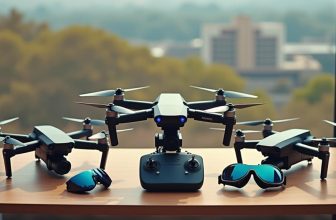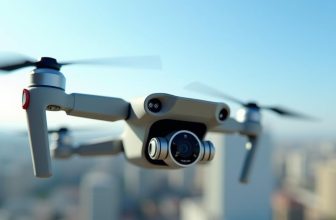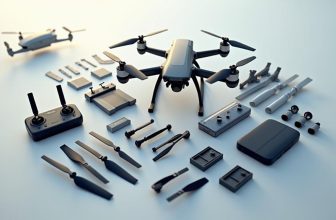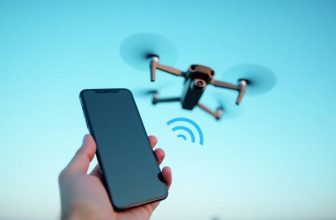
Like Icarus, who soared through the skies with wings of wax, you may have found yourself struggling to navigate the complexities of drone flight. You’re not alone – even experienced pilots can find it challenging to track their drone’s orientation and movement. That’s where Headless Mode comes in – a feature that automatically adjusts the flight path based on controller inputs. But what exactly is Headless Mode, and how does it work its magic? As you prepare to take to the skies, understanding this feature can be the key to unshackling a smoother, more enjoyable flying experience – but how?
Contents
Key Takeaways
- Headless Mode simplifies drone operation by automatically adjusting flight paths based on controller inputs.
- Onboard sensors, GPS, and algorithms track the drone’s position, orientation, and movement in Headless Mode.
- Headless Mode enhances flight safety by aligning the drone’s orientation with the pilot’s, reducing accident risks.
- It is beneficial for beginners, aerial photography, and situations requiring consistent flight paths or orientations.
- Headless Mode has limitations, including reliance on a stable GPS signal and potential interference from magnetic sources.
What Is Headless Mode
When you’re flying a drone, you might’ve noticed a mode called “Headless Mode” in the settings.
But what exactly is Headless Mode and how does it fit into your drone’s capabilities? At its core, Headless Mode is a Flight Assist feature that simplifies your drone’s operation.
It’s particularly useful for novice pilots or those who struggle with orientation and navigation.
In essence, Headless Mode allows your drone to automatically adjust its flight path based on your controller inputs.
This mode is an integral part of Drone Autonomy, which refers to a drone’s ability to operate independently and make decisions without human intervention.
With Headless Mode activated, your drone will no longer require you to keep track of its orientation.
Instead, it’ll use its onboard sensors and algorithms to maintain a steady flight path.
How Headless Mode Works
As you engage Headless Mode, your drone’s flight control system kicks into high gear, utilizing a combination of onboard sensors, GPS, and sophisticated algorithms to track its position, orientation, and movement.
These sensors, including accelerometers, gyroscopes, and magnetometers, work together to provide accurate data about the drone’s flight dynamics.
To guarantee accurate navigation, your drone’s sensors need to be properly calibrated.
Sensor calibration is a critical step in configuring the drone for Headless Mode. This process involves aligning the sensors with the drone’s body and adjusting their sensitivity to minimize errors.
Once the sensors are calibrated, the drone’s flight control system makes continuous Gyro adjustments to maintain its orientation and stability.
This process involves fine-tuning the drone’s pitch, roll, and yaw to match the desired flight path. By combining sensor data and GPS information, the drone can accurately determine its position and orientation, allowing it to fly in a consistent and predictable manner.
This seamless integration of sensors and algorithms is what enables your drone to fly efficiently in Headless Mode.
Benefits of Headless Mode
Your drone’s ability to fly in Headless Mode releases a multitude of benefits that can greatly improve your flying experience.
One of the primary advantages of Headless Mode is enhanced flight safety. By aligning the drone’s orientation with yours, you can better anticipate its movements and adjust your commands accordingly, reducing the risk of accidents or losing control of the drone.
Another significant benefit of Headless Mode is its impact on aerial photography.
With the drone’s orientation synchronized with yours, you can more easily capture the desired shots. You can frame your photos and videos without worrying about the drone’s orientation, ensuring that your subject is centered and that you’re capturing the intended perspective.
Additionally, Headless Mode simplifies navigation and control, especially for beginners or those flying in complex environments.
It also reduces the cognitive load associated with tracking the drone’s orientation, allowing you to focus on other aspects of flight, such as altitude and airspeed.
When to Use Headless Mode
Having explored the benefits of Headless Mode on drones, it’s time to weigh the scenarios in which this feature is most effective.
You’ll find that Headless Mode is particularly useful for beginners or those experiencing flight anxiety. When you’re still building drone confidence, this feature can help alleviate some of the pressures associated with traditional flight modes.
When flying in open spaces or areas with minimal obstacles, Headless Mode can be a great option.
This is because it allows you to focus on the drone’s altitude and distance without worrying about its orientation.
Additionally, if you’re capturing aerial footage or photographs, Headless Mode can be beneficial.
It enables you to maintain a consistent camera angle and orientation, even if the drone is facing a different direction.
In situations where you need to track a subject or maintain a specific flight path, Headless Mode can also be an asset.
Limitations of Headless Mode
The drone compass plays a crucial role in maintaining its orientation and navigation.
However, when you’re flying in Headless Mode, you’ll notice that the compass’s accuracy can be affected. This can lead to Mode Confusion, where the drone’s orientation doesn’t match yours, causing disorientation and potential crashes.
Drone Inconsistencies can also occur when flying in Headless Mode.
These inconsistencies can manifest as unpredictable movements or drifting, making it challenging to control the drone. This is often due to the drone’s reliance on GPS and accelerometers, which can be affected by interference or calibration issues.
Another limitation of Headless Mode is its dependence on a stable GPS signal.
If the signal is weak or lost, the drone’s orientation can become unreliable, leading to Mode Confusion. Additionally, Headless Mode can be less effective in areas with high levels of magnetic interference, such as near power lines or metal structures.
To minimize these limitations, it’s imperative to verify your drone is properly calibrated and that you’re flying in an area with a robust GPS signal.
FAQs: Understanding Headless Mode on Drones
Can I Use Headless Mode With Any Drone Model?
You can’t use headless mode with just any drone model, as it’s often limited to specific drone types. Check your drone’s compatibility and model limitations before activating headless mode to avoid potential issues.
You’re charting uncharted skies – does headless mode disrupt your drone’s GPS navigation? Fortunately, it doesn’t; GPS functionality remains intact, ensuring flight precision and altitude hold capabilities, even in headless mode, are unaffected.
Can I Switch to Headless Mode Mid-Flight?
When you’re in mid-air, you can switch to headless mode, but be prepared for potential flight anxiety and mode confusion. Guarantee a seamless shift by maintaining a steady altitude and adjusting your controls accordingly.
Is Headless Mode Compatible With Drone Simulators?
You’ll find that headless mode’s compatibility with drone simulators can be a mixed bag, as virtual training environments often have limitations, and may not fully replicate the complexities of real-world flight scenarios or modes.
Does Headless Mode Impact Drone’s Camera Stabilization?
You’ll notice that headless mode can introduce camera jitter due to gyro adjustment delays. This occurs because the drone’s orientation is recalculated, briefly disrupting camera stabilization, resulting in slightly shaky footage.
Conclusion
You’ve mastered the art of flying a drone, and now it’s time to reap the rewards. In the immortal words of Leonardo da Vinci, ‘the noblest pleasure is the joy of understanding.’ With Headless Mode, you’ve gained a deeper understanding of drone operation, revealing the secrets to effortless flight. As you take to the skies, remember that this feature is your North Star, guiding you towards smoother navigation, improved photography, and a more enjoyable flying experience.






